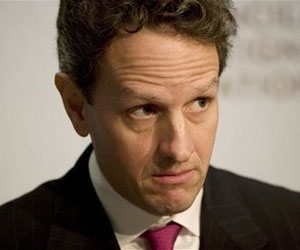
Photo used under a Creative Commons license by flickr user <a href="http://www.flickr.com/photos/congresscheck/" target="_blank">congresscheck</a>
In recent months, Treasury Secretary Timothy Geithner and other regulatory officials have made much ado about those “toxic” securities the Wall Street demons concocted by bundling together thousands of mortgages and dicing them up a dozen different ways to sell to investors. The big problem, as we’ve all learned by now, is that it’s next to impossible to figure out what the accursed things are worth. Wall Street firms and pretty much everyone else went by their exchange price rather than by analyzing the loans within. Which all worked out just fine until the underlying subprime mortgages began defaulting like mad. All of a sudden, nobody wanted to trade in these byzantine assets, and banks that owned heaps of them were in serious trouble.
It’s easy to see why government regulators might want to do something about all of this. The trouble is that much of Geithner’s new $100 billion program to help Wall Street hedge funds purchase “toxic assets” from banks—and which could put us on the hook for up to $500 billion—doesn’t involve these securities at all. Instead, about half of that money goes to a Legacy Loans Program to help hedge funds purchase relatively conventional loans. Yes, plain old loans, as opposed to the nightmarishly complicated mortgage-backed securities that have America’s finance sector scratching its head. “This is a big surprise to me,” says New York University economics professor Lawrence J. White, who helped spearhead the government’s response to the savings and loan crisis during the 1980s. “I don’t know why they’re doing it.”
Why, indeed? A March 23 press release from the Treasury Department claims Geithner’s plan will “reduce uncertainty” on bank balance sheets and help banks and investors figure out what the loans are worth. Yet that’s never really been the issue. Sure, valuing loans involves a bit of forecasting: You have to predict whether a borrower will keep her job, stay healthy, not accumulate other debts, and so forth. But these factors are comparatively easy to calculate. “If you’re talking about individual loans, you can put some value on it,” says Ann Graham, a former litigator with the Federal Deposit Insurance Corporation (FDIC) who now teaches law at Texas Tech University. “It’s far easier than evaluating these exotic mortgage-related securities.”
Geithner’s loan strategy goes beyond merely missing the point. Given years of lax federal oversight, the plan all but guarantees—see if this theme sounds familiar—a windfall for banks that lied to regulators and investors so that they’d be allowed to lend out far more money than they could realistically afford to.
To understand this, a little background is useful: A bank that trades heavily in mortgage-backed securities is in trouble if the market for those assets dries up—and it has, and they are—but regular loans are different. So long as a bank intends to sit on them and collect the interest rather than sell them to another company, the government lets that bank use its own secret financial formula to determine the loan values. In short, banks have carte blanche to claim their assets are worth far more than they really are—White refers to this as “trust me” accounting.
Given this long leash, banking executives have naturally inflated the book value of their mortgages. And even as more and more of their customers fail to make payments, bankers have proved reluctant to admit their hubris and take a hit on the balance sheet. Why is that? Well, the government says banks have to keep enough assets on hand to cover their behinds if things go south. So if a bank that has foolishly overextended itself admits it was overvaluing its loan assets all along, it will fall short of this critical regulatory requirement. And when that happens, under the “prompt corrective action” laws enacted after the savings and loan crisis of the 1980s, federal regulators are obliged to invoke the N-word: nationalization.
But Geithner’s plan is voluntary, meaning that if the naughty banks don’t like the price that hedge fund investors are offering, they can simply turn the deal down. And no bank on the precipice of nationalization is going to voluntarily sell loans to Wall Street for less than it has been claiming they’re worth. Doing so would be corporate suicide. Instead, the only way a troubled bank will likely participate is if it receives an absurdly generous price for its dubious assets—a full-fledged bailout, in other words. “I’m troubled about the pricing aspect of the plan,” notes Graham.
Still confused? Consider this scenario: FirstFed Financial is a California bank whose stock—down 98 percent in the past year—now trades at about 50 cents per share. That gives it a market value of $6.8 million, but the company’s most recent quarterly accounting statement puts its liquidation value—based on how its executives value its loans—at $256.5 million, or $18.74 per share. Clearly, investors don’t believe the loans are worth anywhere near what the company claims. But if FirstFed sells its loans under Geithner’s plan, it will almost certainly score prices close to, or perhaps higher than, those book values. That’s because FirstFed, like many banks these days, has allowed itself a razor-thin capital cushion. If it sells off its loans too cheaply, regulators will be legally obligated to step in and take it over.
Treasury’s treatment of mortgage-backed securities—the more convoluted toxins—is less sinister. Since these assets from hell can only be valued at market prices due to their sheer complexity, getting hedge funds to trade them may at least theoretically serve some useful valuation function. The government is basically letting fund managers make a huge bet, while guaranteeing that we’ll cover most of the losses if things don’t work out.
A similar strategy will apply to the loans, and Geithner clearly wants our most troubled banks to participate—otherwise his plan would do nothing more than subsidize the earnings of healthy companies. But allowing these banks to dispense of their overvalued loans puts him on tenuous legal footing. In fact, using the government to help faltering banks improve their capital position is precisely what the prompt corrective action laws were enacted to prevent.
When the FDIC takes over a bank—a process called receivership—the bank’s shareholders are wiped out and its executives are given the boot. This discourages future investors from putting money into bad institutions and gives regulators a clean slate for disposing of the bank’s assets. It’s exactly what happened in July 2008 when regulators seized exotic-mortgage lender IndyMac. It’s also prudent policy: We don’t want predatory lenders in charge of our economic recovery.
“After the savings and loan debacle, we passed a law because regulators had been too unwilling to close insolvent institutions,” explains William Black, a senior regulator from the 1980s who now teaches law and economics at the University of Missouri-Kansas City. “We mandated that well before banks were insolvent, the government would force them to bring in adequate capital or promptly close them down…That statute has been ignored by the current administration and the last one.”
Indeed, Geithner’s language in describing his bank-rescue plans often comes across as a delicate dance around the letter of law. For instance, he’s conducting “stress tests” to determine what a bank might lose in a “deeper than expected” recession—taxpayers would then subsidize the bank’s losses up to that amount. These stress tests are not much different than the annual audits bank regulators are supposed to conduct to keep banks honest in their accounting. But Geithner can’t publicly admit that loads of bank loans are worthless without nationalizing the banks in question. So, using carefully crafted language to imply that the banks might only take such losses under unthinkable circumstances, Geithner can trample on the spirit of the law. Indeed, his criteria for a deeper-than-expected recession fall suspiciously close to present conditions—they cite an average unemployment rate of 8.9 percent, for instance, at a time when national unemployment stands at 8.5 percent and layoffs are accelerating.
Rep. Barney Frank (D-Mass.), chairman of the powerful House Committee on Financial Services, has acted to further expand this world of make believe. At a March hearing, Frank’s colleagues browbeat US accounting officials into relaxing the rules that require banks to assess mortgage-backed securities at market rates; the change gives bankers leeway to value their inscrutable assets in the same mysterious way they currently value loans.
In a subsequent CNBC interview, Frank openly acknowledged that the purpose of letting banks value these securities themselves is to keep regulators at bay. “We do think the regulators should not have to automatically say, ‘Oh, because these assets have dropped, you’ve gotta cut your lending right away,'” he said.
Treasury Department spokespeople did not respond to phone calls seeking comment, but the FDIC, which will help administer the loan-purchasing program, insists the plan is necessary and that loan values are the subject of controversy. “There’s some uncertainty in the pricing and in their value in the marketplace,” says spokesman Andrew Gray.
Why, though, would bank regulators need hedge funds to help them determine what loans are worth? Assessing loan quality, after all, is something they’ve done for decades. “The regulators will come in and say to the bank, ‘You’re carrying your loans at values that are not appropriate. Mark them down,'” explains Gerard Cassidy, a bank analyst with RBC Capital Markets.
Granted, this hasn’t been happening much lately. Since the financial crisis took hold in earnest, the very accounting gatekeepers charged with protecting our economy from the aforementioned loan-value voodoo have proved excruciatingly slow to make banks write down their loans. This shirking of duties may bear some relationship to the fact that regulators are funded by the fees they levy on banks. When a few banks go under, they can shrug it off, but when banks fail en masse, it’s a payroll disaster. One regulatory organ, the Office of Thrift Supervision, has gone so far as to fudge transaction dates on the books of highly leveraged banks to save them from nationalization.
It’s not as if our government is no longer capable of evaluating a bank’s financial position: When IndyMac was taken over last July, its accounting statements claimed the bank was “well-capitalized”—the strongest regulatory classification. But FDIC officials combing through its books have reported loss rates of around 80 percent on IndyMac’s loans, and understanding those books can help regulators determine the health of other banks.
Bottom line: The notion that regulators need Wall Street to tell them the value of bank loans would be laughable if it weren’t so reckless. These hedge-fund people, after all, were very much part of the problem. “We are in this crisis because the financial interests of investors caused them to deliberately set asset prices in a way that massively inflated values,” Black says.
Even if Geithner has discovered the right mix of smoke and mirrors to push his plan through legally, it seems extremely unwise to reject our best safeguards against financial ruin. The S&L fiasco, after all, taught us that propping up banks and delaying nationalization costs taxpayers far more in the long run. “We have a mechanism to liquidate failed banks, and we know that it works,” Graham says. “You shouldn’t just throw out the things that have worked before.”
Now take a deep breath and let’s boil it all down. Our treasury secretary hopes to circumvent laws enacted to protect the economy by subsidizing a bunch of multimillionaire investors—ostensibly to help regulators fulfill their most basic job description—in a bid to prop up bankers who cooked their books to support a gambling binge and still refuse to admit they lost.
Or maybe they haven’t. In a game thus rigged, there are only two sure-fire losers: you and me.
Zach Carter writes a weekly blog on the economy for the Media Consortium. His work has appeared in The American Prospect, AlterNet, and on CNBC.
















